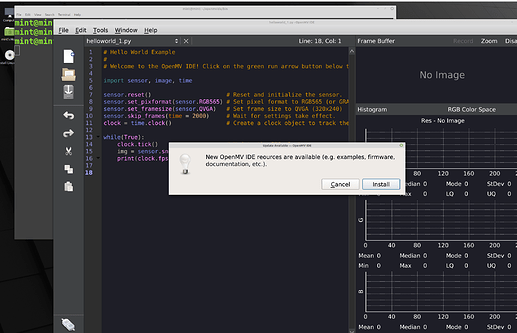Hi,
MicroPython: v1.15-r32 OpenMV: v4.0.2 HAL: v1.9.0 BOARD: OPENMV4P-STM32H743
Type “help()” for more information.
The WiFi examples in the documentation are not correct.
The network library does not have a WLAN class. There is a WINC class.
import network
dir(network)
[‘class’, ‘name’, ‘WINC’, ‘route’]
dir(network.WINC)
[‘class’, ‘name’, ‘bases’, ‘dict’, ‘802_1X’, ‘MODE_AP’, ‘MODE_BSP’, ‘MODE_FIRMWARE’, ‘MODE_P2P’, ‘MODE_STA’, ‘OPEN’, ‘WEP’, ‘WPA_PSK’, ‘connect’, ‘connected_sta’, ‘disconnect’, ‘fw_dump’, ‘fw_update’, ‘fw_version’, ‘ifconfig’, ‘isconnected’, ‘netinfo’, ‘rssi’, ‘scan’, ‘start_ap’, ‘wait_for_sta’]
So far, I have not been able to get my OpenMV CAM H7 Plus connected to the internet. I can not find anything that works in the documentation. I am still trying to figure this out.
8-Dale
WLAN is for the Arduino Portenta H7. The WINC class is for the OpenMV Cam H7 with the WiFi shield.
Did your try out the examples under OpenMV Cam → WiFi Shield?
If you mean examples in the OpenMV IDE, no. I can not read the menus, status bar, terminal text, etc because the text is too small. There should be away to change text sizes and fonts for these.
8-Dale
It’s set by your system font. It should enlarge if your change the system font size.
I am running Linux and the font/font sizes in OpenMV IDE do not change when I change system fonts.
8-Dale
I have this issue too on Linux with HiDPI displays, try this:
QT_SCALE_FACTOR=1.2 ~/openmvide/bin/openmvide
Adjust the scale factor up/down until you find something that works for you, and then you can just add that command to bash script to launch the IDE. Alternatively I use desktop/panel launcher and set this for the command:
env QT_SCALE_FACTOR=2.2 /home/user/openmvide/bin/openmvide
That command does not have any effect on the menu or status text.
8-Dale
Which distribution are you using ? And can you attach some screenshots ?
Hi,
I use Linux Mint 20.1 Mate 64bit.
This is what I see:
8-Dale
I tested it with a fresh linuxmint-20.1-mate-64bit install and it seems to be working fine, tried 1, 1.5 and 2 you can see the menus, buttons and text inside the app get bigger. The window title and decorations seem to be globally set.
QT_SCALE_FACTOR=1.0
QT_SCALE_FACTOR=1.5:
QT_SCALE_FACTOR=2.0:
OK. When I set QT_SCALE_FACTOR, everything is affected, including text in the code window. I do not want the text in the code window to be affected. As you can see in the attached screenshot, It makes the code window text HUGE, which is unusable. I have to set QT_SCALE_FACTOR=3.0 to get the menus to where I can read them without straining my eyes.
8-Dale
In the text editor press ctrl and “-” will zoom out.
Ah, OK! That works and leaves the menus and such large enough that I can still read them.
Now, getting back to the WiFi examples, I tried the connect.py script after I added my network said and password. Those are the only changes I made. Line 13 is “wlan = network.WINC()”
I have no idea what is wrong. I have my WiFi shield mounted with the antenna facing away from the camera lens.
I get the following errors:
Traceback (most recent call last):
File “”, line 13, in
OSError: Failed to initialize WINC1500 module: Init failed!
MicroPython: v1.15-r32 OpenMV: v4.0.2 HAL: v1.9.0 BOARD: OPENMV4P-STM32H743
Type “help()” for more information.
8-Dale
That’s upside down, you can see in the product page we have a photo that shows how it should be connected WiFi Shield | OpenMV
Thank you. Can not get the WiFi module initialized now. There is a syntax issue somewhere. I will work more on this later or tomorrow.
8-Dale
OK, I have a way to make this work now. I have the openmvide in my PATH and I created a small script:
`#!/bin/bash
QT_SCALE_FACTOR=3 openmvide`
This works!  Sorry for the problems,
Sorry for the problems,
8-Dale





